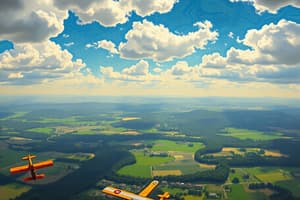Podcast
Questions and Answers
Where is Class D airspace generally found?
Where is Class D airspace generally found?
Smaller or less busy towered airports, usually without approach radar.
What is the typical configuration of Class D airspace?
What is the typical configuration of Class D airspace?
Circular area around airport, 4 NM radius. May have extensions to include instrument approach/departure paths.
What are the typical altitudes of Class D airspace?
What are the typical altitudes of Class D airspace?
Surface to 2,500' above airport elevation.
What are the entry requirements for Class D airspace?
What are the entry requirements for Class D airspace?
What are the communications requirements in Class D airspace?
What are the communications requirements in Class D airspace?
What equipment is required in Class D airspace?
What equipment is required in Class D airspace?
What are the pilot certification requirements in Class D airspace?
What are the pilot certification requirements in Class D airspace?
What type of traffic separation is provided by ATC in Class D airspace?
What type of traffic separation is provided by ATC in Class D airspace?
What is the speed limit in Class D airspace?
What is the speed limit in Class D airspace?
How is Class D airspace depicted on a VFR sectional chart?
How is Class D airspace depicted on a VFR sectional chart?
What are the basic VFR weather minimums for Class D airspace?
What are the basic VFR weather minimums for Class D airspace?
If the control tower closes at night, what happens to the Class D airspace?
If the control tower closes at night, what happens to the Class D airspace?
What is a TRSA?
What is a TRSA?
Flashcards are hidden until you start studying
Study Notes
Class D Airspace Overview
- Class D airspace is typically found around smaller, less busy towered airports that often lack approach radar services.
Configuration
- Defined by a circular area, extending 4 nautical miles (NM) from the airport center.
- May include extensions for instrument approach and departure paths.
Altitudes
- Class D airspace ranges from the surface to 2,500 feet above the airport elevation.
Entry Requirements
- Establish two-way communications with Air Traffic Control (ATC) is mandatory; ATC must acknowledge with the pilot's callsign.
Communication Protocol
- Pilots must maintain continuous, two-way communication with ATC while inside Class D airspace.
Equipment Necessities
- A two-way radio is required for pilots operating within Class D airspace.
Pilot Certification
- Student pilots are permitted to operate in Class D airspace.
Traffic Separation
- ATC provides traffic separation services for IFR (Instrument Flight Rules) flights within Class D airspace.
Speed Limit
- A speed limit of 200 knots applies when flying at or below 2,500 feet AGL (Above Ground Level) within 4 NM of the primary airport.
VFR Sectional Chart Representation
- Class D airspace is depicted by dashed blue lines on VFR sectional charts, with a blue number in a dashed box indicating the MSL (Mean Sea Level) ceiling altitude (last two zeros are omitted).
VFR Weather Minimums
- Basic VFR weather minimums for Class D require 3 statute miles visibility and cloud clearances of 500 feet below, 1,000 feet above, and 2,000 feet horizontally from clouds.
Nighttime Operations
- If the control tower closes at night, Class D airspace transitions to Class E (if continuous weather reporting is available) or Class G (if not). Consult the Airport/Facility Directory for specifics.
TRSA Definition
- Terminal Radar Service Area (TRSA) offers optional radar approach control services at select Class D airports.
Studying That Suits You
Use AI to generate personalized quizzes and flashcards to suit your learning preferences.




